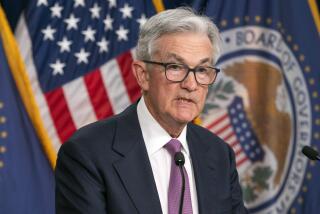Fed is open to altering bond policy
WASHINGTON â Federal Reserve policymakers signaled for the first time that they could âincrease or reduceâ their controversial efforts to stimulate the economy in the future, but for now theyâre holding pat.
After a two-day policy meeting, the Federal Open Market Committee voted 11 to 1 to maintain its rock-bottom interest rates and continue its so-called quantitative easing program of purchasing $85 billion of Treasury and mortgage-backed securities each month.
The central bank announced no new actions as the economy appeared headed for another spring slowdown.
However, the Fed opened the door to changes in the bond-buying program that started last fall. The Fedâs policy statement Wednesday said it was prepared to âincrease or reduceâ the pace of its purchases. The language suggested changes could be coming in the program depending on the state of the recovery.
The Fed did not say it was seeing indications that growth was slowing. It said data suggest that âeconomic activity has been expanding at a moderate pace.â
Even though the jobs market has shown âsome improvement in recent months,â the Fed said, the unemployment rate remains âelevated.â
The statement also took a swipe at Washington politicians who have been battling over taxes and budget cuts, saying that âfiscal policy is restraining economic growth.â
Fed officials left the key short-term interest rate at near zero, the same level in place since late 2008, in hopes of spurring businesses to spend money.
The Fed reiterated its intention to keep the rate at that level as long as the jobless rate is above 6.5% and inflation is projected to be close to the central bankâs 2% annual target rate. The unemployment rate was 7.6% in March.
The Fed meeting comes amid signs that the economic recovery is stalling after accelerating in the first quarter.
Economists are concerned that tax increases at the start of the year and the so-called sequester, the large automatic federal budget cuts that began March 1, are slowing growth.
On Wednesday, payroll processing firm Automatic Data Processing Inc. said private-sector job growth slowed in April. Employers added just 119,000 net new workers, down from 131,000 in March, it said.
It was the second straight decline in ADPâs monthly survey and it surprised analysts, who had expected the report to show 150,000 new private-sector jobs in April.
The government will release its April jobs report Friday. Economists are expecting an improvement from March, when the economy added a disappointing 88,000 jobs.
Besides the lower ADP numbers, there were two other weak economic readings Wednesday. The Commerce Department said construction spending was down 1.7% in March from the previous month. And the Institute for Supply Managementâs purchasing managers index showed manufacturing growth slowed in April to its slowest pace this year.
Since 2008, when it first started taking unprecedented steps to boost growth, the Fed has exhausted much of its fire-power and canât do much more to stimulate the economy beyond buying more bonds, experts have said.
More to Read
Inside the business of entertainment
The Wide Shot brings you news, analysis and insights on everything from streaming wars to production â and what it all means for the future.
You may occasionally receive promotional content from the Los Angeles Times.











